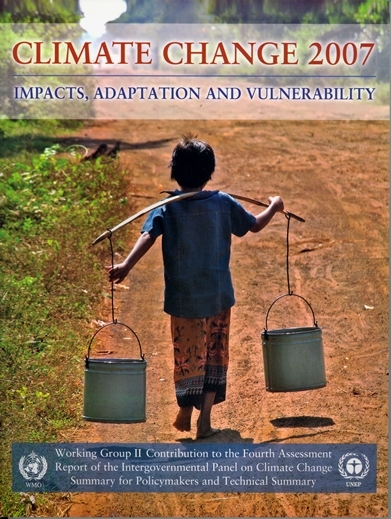IPCC Fourth Assessment Report, Working Group II: Appendix 5
| Topics: |
Originally published by our Content Partner: Intergovernmental Panel on Climate Change (other articles)
Permissions to publish have been granted by the following copyright holders:
Fig. 1.2: Reprinted by permission from Macmillan Publishers Ltd [Nature]: O’Reilly, C.M. and Co-authors, 2003: Climate change decreases aquatic ecosystem productivity of Lake Tanganyika,Africa. Nature, 424, 766-768. Copyright 2003.
Fig. 1.3: From Beaugrand, G. and Co-authors, 2002b: Reorganization of NorthAtlantic marine copepod biodiversity and climate. Science, 296, 1692-1694. Reprinted with permission from AAAS.
Fig. 1.4(a): From Menzel,A. and Co-authors, 2005b: ‘SSW to NNE’: NorthAtlantic Oscillation affects the progress of seasons across Europe. Glob. Change Biol., 11, 909-918. Reprinted with permission from Blackwell.
Fig. 1.5: From Nemani, R.R. and Co-authors, 2003: Climate driven increases in global terrestrial net primary production from 1982 to 1999. Science, 300, 1560-1563. Reprinted with permission from AAAS.
Fig. 1.6: From Menzel,A. and Co-authors, 2006b: European phenological response to climate change matches the warming pattern. Glob. Change Biol., 12, 1969-1976. Reprinted with permission from Blackwell.
Fig. 2.7: From Schröter, D. and Co-authors, 2005: Ecosystem service supply and vulnerability to global change in Europe. Science, 310, 1333-1337. Reprinted with permission from AAAS.
Fig. 3.3: FromArnell, N.W., 2003a: Effects of IPCC SRES emissions scenarios on river runoff: a global perspective. Hydrol. Earth Syst. Sc., 7, 619-641. Reprinted with permission from the European Geosciences Union.
Fig. 3.4: Reprinted by permission from Macmillan Publishers Ltd [Nature]: Milly, P.C.D., K.A. Dunne andA.V. Vecchia, 2005: Global pattern of trends in streamflow and water availability in a changing climate. Nature, 438, 347-350. Copyright 2005.
Fig. 3.5: Reprinted with permission from Petra Döll.
Fig. 3.6: Reprinted from Lehner, B. and Co-authors, 2005: Estimating the impact of global change on flood and drought risks in Europe: a continental, integrated assessment. Climatic Change, 75, 273-299, with kind permission from Springer Science and Business Media.
Fig. 3.7: Reprinted with permission from Denise Neilsen.
Figs. 3.8, 5.1(b) and TS.5: From Nohara, D. and Co-authors, 2006: Impact of climate change on river runoff. J. Hydrometeorol., 7, 1076-1089. Reprinted with permission from American Meteorological Society.
Fig. 5.1(a): From Fischer, G. and Co-authors, 2002: Global agro-ecological assessment for agriculture in the 21st century: methodology and results. Research Report RR-02-02. International Institute forApplied SystemsAnalysis (IIASA), Laxenburg,Austria. Reprinted with kind permission of IIASA.
Fig. 9.3: FromArnell, N.W., 2006b: Climate change and water resources: a global perspective. Avoiding Dangerous Climate Change, H.J. Schellnhuber,W. Cramer, N. Nakićenović, T. Wigley and G. Yohe, Eds., Cambridge University Press, Cambridge, 167-175. Reprinted with permission from
Cambridge University Press.
Fig. 10.3(a): From Kurihara, K. and Co-authors, 2005: Projections of climatic change over Japan due to global warming by high resolution regional climate model in MRI. SOLA, 1, 97-100. Reprinted with permission from the Meterological Society of Japan.
Fig. 10.3(b): From Japan MeteorologicalAgency, 2005: Global Warming Projection, Vol.6 - with the RCM20 and with the UCM, 58 pp. Reprinted with permission from the Japan MeteorologicalAgency.
Figs. 12.4 and TS.13: Reprinted by permission from Macmillan Publishers Ltd [Nature]: Schär, C. and Co-authors, 2004: The role of increasing temperature variability in European summer heatwaves. Nature, 427, 332-336. Copyright 2004.
Fig. 13.1(a): From Haylock, M.R. and Co-authors, 2006: Trends in total and extreme SouthAmerican rainfall 1960-2000 and links with sea surface temperature. J. Climate, 19, 1490-1512. Reprinted with permission fromAmerican Meteorological Society.
Fig. 13.1(b): FromAguilar, E. and Co-authors, 2005: Changes in precipitation and temperature extremes in CentralAmerica and northern SouthAmerica, 1961–2003. J. Geophys. Res., 110, D23107, doi:10.1029/2005JD006119. Copyright (2005) American Geophysical Union.
Fig. 13.3: Reprinted by kind permission of the Livestock Environment and Development Virtual Centre of the Food and Agricultural Organization.
Fig. 15.4: From Smith, L.C. and Co-authors, 2005: DisappearingArctic lakes. Science, 308, 1429. Reprinted with permission from AAAS.
Fig. 16.1: From Bryant, D. and Co-authors, 1998: Reefs at Risk: A Map-Based Indicator of Threats to the World’s Coral Reefs. World Resources Institute,Washington, District of Columbia, 56 pp. Reprinted by permission ofWorld Resources Institute: http://www.wri.org.
Figs 17.2 and TS.17: Reprinted from O’Brien, K. and Coauthors, 2004: Mapping vulnerability to multiple stressors: climate change and globalization in India. Global Environ. Chang., 14, 303-313, with permission from Elsevier.
Fig. 19.1: Reprinted from Hare, B. and M. Meinshausen, 2005: How much warming are we committed to and how much can be avoided? Climatic Change, 75, 111-149, with kind permission from Springer Science and Business Media.
Table 20.1: From MA(Millennium EcosystemAssessment), 2005: Ecosystems and Human Well-Being: Synthesis. Island Press,Washington, District of Columbia, 155 pp. Reprinted by permission ofWorld Resources Institute: http://www.wri.org.
Fig. 20.2: Reprinted from Swart, R., J. Robinson and S. Cohen, 2003: Climate change and sustainable development: expanding the options. Climate Policy, 3, S19-S40, with permission from Elsevier.
Fig. 20.3(b): From Stern, N., 2007: The Economics of Climate Change: The Stern Review. Cambridge University Press, Cambridge, 692 pp. Crown copyright.
Fig. 20.4: FromWatkiss, P. and Co-authors, 2005: The social costs of carbon (SCC) review: methodological approaches for using SCC estimates in policy assessment. Final Report, Defra,
UK, 124 pp. Copyright: Queen’s Printer and Controller of HMSO 2006; reproduced under the terms of the Click-Use Licence.
|
|
